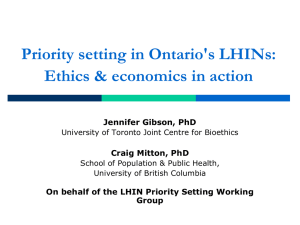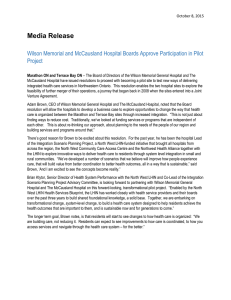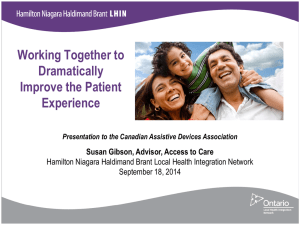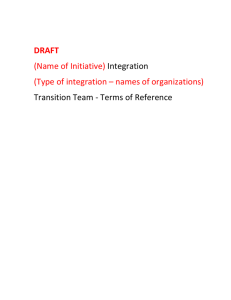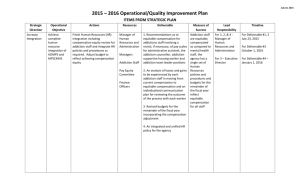Transforming Health Care in Ontario
advertisement
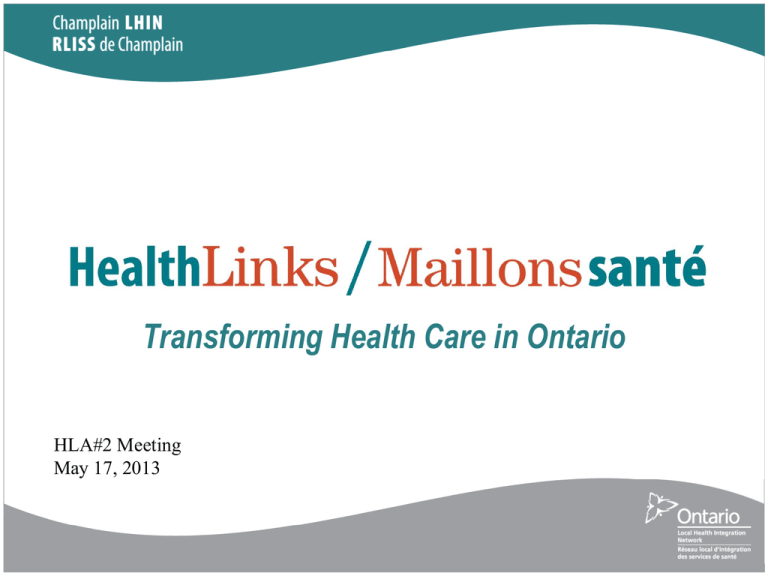
Transforming Health Care in Ontario HLA#2 Meeting May 17, 2013 Purpose 1) Explain the Health Link concept and alignment to the Champlain Integrated Health Service Plan 2013-16 2) Review characteristics of Champlain Health Link Areas 3) Clarify the process and expectations of the Readiness Assessment 2 Health Links “Health Links will break down barriers for Ontarians, making access to health care easier and less complicated. By encouraging local health providers to work together to co-ordinate care for individual patients, we’re ensuring our most vulnerable patients – seniors and those with complex conditions – get the care they need and don’t fall between the cracks.” Deb Matthews, Minister of Health and Long-Term Care 3 A New Model of Care in Ontario • Health care providers in a geographic area work together to provide coordinated care for patients • Patient-centred solutions • Initially focused on people with the highest needs / highest cost to the health system • Brings family health care into the broader health care system • faster access to primary care • faster ability to connect patients with specialists, home care services and other community supports • improved transitions of care 4 Health Link - Key Features • Focus on a defined region (at least 50,000 population) • Ability to identify and track complex patients • Include providers that care for complex patients (minimum CCAC, hospital, primary care & specialists); voluntary participation • Includes primary care providers (minimum 65% from the geographic area) • Identifies a lead organization. • Already show a high degree of collaboration and willing to formalize it with a written agreement 5 Providers will work together at the clinical level to achieve: Short Term: • Develop coordinated care plans for complex patients • Increase number of complex patients with regular and timely access to a primary care provider 6 Providers will work together at the clinical level to achieve: (cont’d) Longer Term: • Introduce same day/next day access to primary care • Primary care follow-up within seven days of discharge from an acute care setting • Reduce time from a primary care referral to specialist and home care • Reduce unnecessary hospital admissions and re-admissions within 30 days of discharge • Reduce avoidable Emergency Room visits for patients with conditions best treated elsewhere • Reduce Alternate Level of Care days in hospital • Enhance the patient experience. 7 Supports for Health Links • Ministry of Health and Long-Term Care • Ministry-Led Process • Setting direction and performance metrics • One-time funding • Removing Barriers • Communications • Evidence based tools and resources • eHealth Ontario • Health Quality Ontario • OTN • LHIN • Other Health Links 8 Champlain LHIN Integrated Health Service Plan 2013-2016 for a Person-Centred Regional Health Care System Vision: Healthy people and healthy communities supported by a quality, accessible health system Mission: Building a coordinated, integrated and accountable health system for people where and when they need it Values: Respect, Trust, Openness, Integrity, Accountability 9 IHSP Strategies & Actions Strategy 1 Strategy 2 Strategy 3 Build a strong foundation of integrated primary, home and community care Improve coordination and transitions of care Increase coordination and integration of services among hospitals • Public Engagement • Public Engagement • Public Engagement • Integrated Health Networks • Continuity of Care • Regional Programs • Early Identification and Management of Risk • Information Sharing • Central Intake • System Navigation • Intensive Case Management • Emergency Room Initiatives • Advanced Access to Service • Clinical Guidelines and Pathways • Funding Reform 10 How Champlain Health Link Areas were Defined Applying the criteria: Staff studied data for 34 smaller ‘starter’ areas and combined them into 10 based on: • Adjacency • Critical mass (population, people with high needs, primary care and other providers) • Population characteristics (distribution & demographics) • Which hospitals people tend to use • Our understanding of local areas • Alignment with census and Ottawa Neighbourhood Study boundaries. 11 Some High-Needs Groups (Champlain residents 2011-12) 1) Had two+ acute care hospitalizations: 13,939 • Had a readmission within 30 days: 8,961 2) Had a high cost acute care hospital stay: 8,145 People with High Needs come in many shapes and sizes. No single data definition can capture the complexity. 3) Made 5+ emergency department visits: 16,305 • Composite: met one or more criteria: 30,514 • Met all three criteria: 1,117 12 13 Implemention Process for Champlain Health Links (as of Apr 16, 2013) Ministry of Health and Long-Term Care Leader & Enabler Champlain LHIN Interested Providers Facilitators & Supporters Implementers Develop Health Link Strategy & Framework - Engage with potential HL groups (provincial definitions, tools, data) - Provide local tools and resources Organize providers / networks Review Readiness Assessment Readiness Assessment complete? Submit Readiness Assessment No Revise Readiness Assessment Swimlane Process for Health Links Implementation Yes Review / Approve Readiness Assessment Submit readiness assessments Review and flow initial funding for HL to develop business plan Support HL’s business plan development - Develop & submit Business Plan - Partners sign MOU Review Business Plan Business Plan complete? No Revise & resubmit Business Plan Yes Approve Business Plan & flow funding Assumptions - Provider groups will organize themselves, based on the information provided to them by the LHIN / Ministry - LHIN approves Readiness Assessment and Business Plans before sending to Ministry. - All Health Links’ submissions are approved by Ministry. - Health Links will be implemented when they are ready, not by LHIN quota (50% by xx date) Submit Business Plan Implement accountability agreements Sign accountability agreement & operationalize Health Link Support and monitor Health Link implementation Monitor and support growth and improvements 14 Readiness Assessments need to include: • Evidence it was completed as a collaboration of providers, with a patient- centred focus (minimum PC, CCAC & hospital, specialists) • A lead organization has been agreed upon by the collaborating partners & clearly identified • A description of Aboriginal population and collaborating partners to meet needs • For each criterion of the Readiness Assessment template, the rationale / explanation section is completed and clearly written • An understanding of the Francophone population and their needs & an explanation of the a capacity to meet the needs of Francophones 15 Helpful Tips • • • Keep the focus on patients with the highest complexity and health system use Try not to get hung up on the “lead” organization Prepare a concise & clear RA – answer each criterion Ministry website www.Ontario.ca/LeadingHealthy Change LHIN website: www.champlainlhin.on.ca LHIN email: Ch.pclead@lhins.on.ca 16 Questions 17
